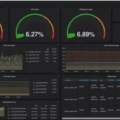Software deployment is an essential part of any modern business. It enables businesses to quickly and easily deploy new applications, updates, and patches to their systems. The right software deployment solution can help organizations streamline the process, reduce costs, and ensure successful deployments.
When it comes to software deployment solutions, there are many options available. There are cloud-based solutions that provide automated software installation services as well as patch management tools. There are also on-premise solutions that allow users to deploy applications directly from their own data centers.
One of the most popular software deployment tools is Atera. This cloud-based solution is integrated with a patch manager for efficient deployment of applications and updates. It also provides automated installation services for both Windows and Mac OS X operating systems. Atera offers a range of features such as remote monitoring, reporting, patch management, and user management to make sure that your system is up-to-date with the latest versions of your applications.
Another popular software deployment tool is Octopus Deploy. This solution allows users to create repeatable deployments for any type of application or service in any language or platform including .NET, Java, Ruby on Rails, NodeJS, and more. Octopus Deploy also offers easy integration with existing CI/CD pipelines allowing users to quickly deploy changes without having to manually configure them each time they want to update their applications or services.
Jenkins is another popular tool for automating software deployments across environments such as development, test, staging, and production environments. Jenkins supports a wide range of plugins that allow users to easily customize their deployments based on specific requirements without having to write custom scripts or code from scratch every time they want to deploy something new or update an existing application or service.
Finally, there are other tools such as TeamCity, DeployBot, and GitLab which all offer similar features but focus more on continuous integration/delivery (CI/CD) pipelines rater than just plain software deployments as Atera does. Each one has its own unique features but all offer great automation capabilities for deploying applications quickly and efficiently across multiple platforms in an automated manner without requiring manual intervention each time you need to deploy something new or update existing components of your system(s).
Overall there are many different software deployment tools available today that can be used by organizations of any size regardless of their technical expertise or budget constraints making it easier than ever before for businesses to manage the entire lifecycle of their applications from development through testing and into production in a streamlined manner while ensuring successful deployments each time they need them!

Deployment of Software
Deployment in software essentially refers to the process of making a software application or system available to users. This includes activities such as installation, configuration, testing, and maintenance of the software. It is often done in a distributed environment with multiple systems involved. Deployment can also refer to the physical location of the software, such as on-premises or cloud-based systems. The deployment process involves making sure that all components are properly set up and configured before they are made available for use. Additionally, this process may include creating backups of the system or performing other tasks necessary to ensure its successful operation.
Software Used for Deployment
Atera is a cloud-based remote monitoring and management (RMM) software platform that provides an automated software installation service. Atera provides a patch manager to help you deploy software quickly and easily, while also ensuring all your systems are up-to-date with the latest security patches. With Atera, you can remotely deploy software to any system without having to physically access the device. You can also configure settings for each system, schedule deployments, and track deployment progress from one central location. Additionally, Atera’s intuitive dashboard allows you to monitor the status of all your systems in real-time, so you always know if any installations are failing or succeeding.
The Best Tool for Deployment
The best deployment tool for your needs depends on a few factors, such as the size and complexity of your project, the type of development process you use, and the number of people involved. AWS CodeDeploy is an excellent choice for many types of projects, as it allows developers to quickly deploy code to multiple servers in multiple regions. Octopus Deploy is another popular option that allows users to automate deployments across a variety of platforms. Meanwhile, Jenkins is a great option for larger projects that require more complex builds and automated testing. For teams working with version control systems like Git or Subversion, TeamCity and DeployBot are both excellent choices that offer powerful version control capabilities. Finally, if you’re looking for an all-in-one solution that can handle everything from CI/CD pipelines to deployment pipelines, then GitLab and Bamboo are both reliable options. Ultimately, the best tool for deployment depends on your specific requirements – so make sure to evaluate each tool carefully before making a decision.
Deploying Software
To deploy your software using Configuration Manager, first open the Configuration Manager console and go to the Software Library workspace. Under Application Management, select either the Applications or Application Groups node and pick an application or application group from the list to deploy. Then, in the ribbon, select Deploy. This will launch the deployment wizard, which will guide you through the process of deploying your software.
Deployment Models
The three deployment models are Software as a Service (SaaS), Platform as a Service (PaaS), and Infrastructure as a Service (IaaS).
Software as a Service (SaaS) is a cloud computing model where applications are provided to users over the Internet from a centrally hosted service provider. In this model, customers don’t need to install or maintain any software or hardware on their end. Instead, they use the software through the service provider’s platform. Examples of SaaS include web-based email clients, online office suites, and customer relationship management systems.
Platform as a Service (PaaS) is another cloud computing model where users can develop, test, host and manage applications without having to worry about keeping up with system maintenance or managing infrastructure. In this model, the cloud service provider takes care of the underlying infrastructure and provides an environment with tools for the development and deployment of applications. Examples of PaaS include Google App Engine and Microsoft Azure.
Infrastructure as a Service (IaaS) is the most basic cloud computing service where customers rent IT infrastructure such as servers, storage devices, virtual machines, networks, and other related services from providers on demand. In this model, customers have full control over the IT resources they rent and are responsible for maintaining them. Examples of IaaS include Amazon Web Services (AWS) and Microsoft Azure Virtual Machines.
Types of Deployment
There are several different types of deployment that businesses and organizations can use depending on their needs. Commercial Deployments involve selling applications or software directly to consumers or other businesses. Internal Deployments are used within a company or organization, such as with an internal application development project. Hosted Service Deployments involve using an external service provider to manage the hosting and delivery of applications and services over the internet. Single User Deployments are suitable for small-scale projects, such as when just one user needs access to a certain application. Concurrent Deployments allow multiple users to access the same application at once, while Server Deployments involve the installation of software on a central server. Cloud Deployments use cloud computing technology to help deliver applications and services over the internet. Finally, Multi-User Deployments allow multiple users to access the same application simultaneously from different devices.
Is Jira a Deployment Tool?
No, Jira is not a deployment tool. It is a project management and issue-tracking software that can be used to help manage the process of deploying software or other changes. Instead, Jira works with existing deployment tools to help track the progress of deployments within your team’s workflow. By integrating with your deployment tool, Jira can help you create and maintain visibility into the life cycle of any given deployment from start to finish.
What is Deployment in the IT Industry?
In the IT industry, deployment is the process of putting software into operation in its production environment. This includes releasing the software for use by end-users, as well as installing or updating software on existing hardware and configuring it for use. Deployment activities typically involve setting up the necessary infrastructure, such as networks and servers, testing to ensure compatibility with other systems, performing data migrations, and integrating with other applications. After deployment is complete, it is important to monitor the system’s performance to ensure the proper functioning and identify any problems that may arise.
Understanding DevOps Deployment
DevOps deployment is the process of creating, configuring, and managing software applications in a production environment. It involves taking code from version control, testing it for production readiness, and then delivering it to the public. DevOps deployment helps ensure that applications are up-to-date, secure, and running optimally by automating the process of moving code from development to production. This allows developers to focus on developing new features and bug fixes while operations teams can quickly deploy them in production. DevOps tools like Jenkins, Chef, Ansible, and Kubernetes help automate the deployment process by allowing you to define pipelines, track deployments, and roll back changes if necessary. By deploying applications regularly and frequently with DevOps practices, businesses can ensure their applications are available when customers need them most.
The Purpose of Deploying
The purpose of deploying is to ensure that changes to a product or service can be quickly and effectively implemented, tested, and deployed to customers. Deployment allows developers to push code updates and patches quickly, enabling users to benefit from the latest features and fixes without experiencing any disruptions. It also helps maintain the quality of the product or service by ensuring that all new code is tested and verified before being released. The deployment also helps keep customers informed about the progress of development, allowing them to provide feedback throughout the process. Finally, deployment allows developers to track and analyze usage data in order to identify areas for improvement or suggest new features.
What is Deployment in IT?
Deploying in IT refers to the process of installing and configuring software and hardware components in order to make them operational. This includes connecting the components to existing networks and systems, as well as ensuring they are properly configured and integrated with existing systems. The goal of deploying is to ensure that all components are correctly set up and ready to be used by end users. Deployment can involve a variety of tasks such as setting up servers, configuring applications, creating databases, setting up networks, and more. The deployment process typically involves testing each component before it is made life, ensuring that all aspects of the system are functioning properly prior to release.
Conclusion
In conclusion, software deployment is an essential part of any organization’s IT infrastructure. It allows for the efficient and effective distribution of software across multiple systems, making it possible for teams to stay up-to-date with the latest versions of their applications and services. There are a variety of tools available for software deployments, such as Atera, AWS CodeDeploy, Octopus Deploy, Jenkins, TeamCity, DeployBot, GitLab, Bamboo, and CircleCI. All of these tools offer different benefits and features that can help streamline the software deployment process. Ultimately, choosing the right tool depends on your organization’s specific needs and requirements.








